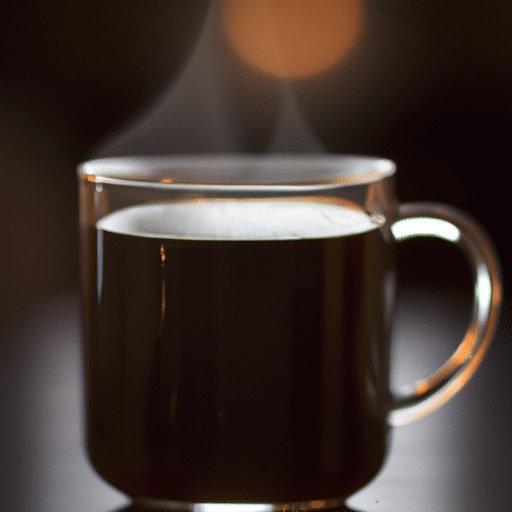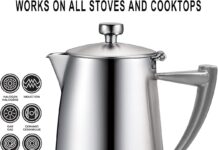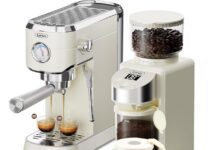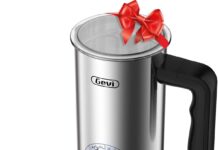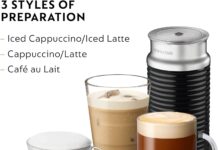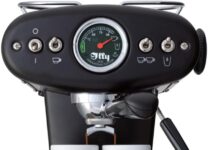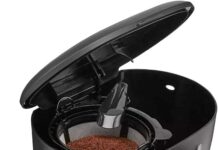Ladies and gentlemen, coffee lovers and aficionados, we have embarked on a quest to uncover the ultimate answer to the age-old question – what coffee maker makes coffee that tastes the best? From the aroma that fills the air when you wake up to that first sip that ignites your senses, we all yearn for the perfect cup of joe. Join us as we venture into the world of coffee makers, exploring their features, functionality, and the art of brewing to unveil the secrets behind that perfect, blissful cup of coffee. Get ready to indulge in our caffeine-filled journey, where taste reigns supreme!
Comparison of Different Coffee Makers
When it comes to making a delicious cup of coffee, the choice of coffee maker is crucial. There are several different types of coffee makers available, each with its own unique brewing method and characteristics. In this article, we will explore the differences between drip coffee makers, French press, pour-over coffee makers, and espresso machines. By understanding the features and benefits of each, you can find the coffee maker that best suits your taste preferences.
Drip Coffee Makers
Drip coffee makers are one of the most commonly used types of coffee makers. They work by heating water and then pouring it over ground coffee beans, using gravity to extract the flavors and aromas. There are two main types of drip coffee makers: automatic and manual.
Automatic Drip Coffee Makers
Automatic drip coffee makers are incredibly convenient and user-friendly. They typically have built-in timers, allowing you to set the brewing process to start automatically at a specific time. This is perfect for those of us who like to wake up to the smell of freshly brewed coffee. Automatic drip coffee makers also come with a variety of brewing options, such as adjustable strength settings and programmable brewing temperatures.
Manual Drip Coffee Makers
On the other hand, manual drip coffee makers provide a more hands-on brewing experience. These coffee makers require you to pour hot water over the coffee grounds yourself, giving you more control over the brewing process. Manual drip coffee makers are often preferred by coffee enthusiasts who enjoy experimenting with different variables, such as water temperature and pour speed, to achieve the perfect cup of coffee.
French Press
The French press is a classic and beloved coffee maker known for its simplicity and rich flavor. It consists of a carafe with a plunger and a metal mesh filter. To brew coffee using a French press, you simply add coarsely ground coffee to the carafe, pour hot water over it, and let it steep for a few minutes. Then, you press the plunger down, separating the coffee grounds from the brewed coffee.
Construction and Design
French presses are typically made from glass or stainless steel, with a heat-resistant handle for safe pouring. The plunger and filter assembly are essential components as they allow you to separate the coffee grounds from the coffee without the need for paper filters.
Brewing Process
The brewing process of a French press involves full immersion, meaning the coffee grounds are completely submerged in water. This method allows for a longer extraction time, resulting in a bolder and stronger coffee flavor. However, it’s essential to pay attention to the brewing time, as leaving the coffee in the French press for too long can lead to over-extraction and a bitter taste.
Coffee Quality
French press coffee is known for its robust and full-bodied flavor profile. The metal mesh filter used in French presses allows more oils and fine particles to pass through, enhancing the coffee’s natural flavors. This results in a coffee with a rich mouthfeel and a depth of flavor that is especially popular among coffee enthusiasts.
Pour-Over Coffee Makers
Pour-over coffee makers provide a manual brewing method that allows for precise control over every aspect of the brewing process. This type of coffee maker uses a cone-shaped brewer and a filter to create a clean and nuanced cup of coffee.
Benefits of Pour-Over Brewing
Pour-over brewing offers several benefits that contribute to an exceptional coffee experience. Firstly, the slow and controlled pouring technique allows for saturation of the coffee grounds, ensuring an even extraction of flavors. Additionally, the cone-shaped brewer and the filter minimize contact between the coffee and the water, resulting in a clean cup of coffee with reduced sediment.
Manual vs Automatic Pour-Over
While manual pour-over brewing provides the ultimate control, some coffee makers offer automatic pour-over capabilities. Automatic pour-over coffee makers use pre-programmed settings to mimic the precise pouring technique of a skilled barista. This allows you to enjoy the benefits of pour-over brewing without the need for hands-on involvement.
Paper vs Metal Filters
Pour-over coffee makers often give you the option to choose between paper and metal filters. Paper filters tend to produce a cleaner cup of coffee as they trap more oils and sediment. On the other hand, metal filters allow some oils to pass through, resulting in a fuller-bodied and potentially more flavorful cup of coffee. The choice between paper and metal filters ultimately comes down to personal preference and desired coffee flavor.
Coffee Taste and Pour-Over
The pour-over brewing method is known for producing a bright and delicate cup of coffee. By allowing for precise control over various variables, including water temperature, pouring speed, and grind size, pour-over coffee makers can bring out the nuanced flavors and aromas of different coffee beans. This brewing method is particularly popular among coffee aficionados who enjoy exploring the subtleties of specialty coffee.
Espresso Machines
Espresso machines are a staple in coffee shops and a popular choice for those who love intense and concentrated coffee. These machines use pressure to force hot water through finely ground coffee, extracting the flavors and creating a small yet strong shot of espresso.
Types of Espresso Machines
There are several types of espresso machines available, ranging from manual lever machines to fully automatic espresso machines. Manual lever machines require the user to pull a lever to control the water flow and pressure, while semi-automatic and fully automatic machines have built-in pumps that regulate the extraction process. Fully automatic machines are the most user-friendly and convenient option, as they handle all aspects of the brewing process, including grinding, tamping, and extraction.
Quality of Espresso Shots
High-quality espresso machines are designed to achieve optimal extraction of coffee flavors. The pressure applied during the brewing process helps to extract a concentrated shot of espresso with a layer of crema on top. The crema, a blend of oils and carbon dioxide, adds to the overall flavor and texture of the espresso. A well-made shot of espresso should have a balanced and robust flavor, often described as bold, smooth, and slightly sweet.
Steaming and Frothing Milk
Espresso machines often come equipped with a steam wand, allowing you to froth and steam milk to create specialty coffee drinks like cappuccinos and lattes. Steaming milk adds another dimension of flavor and texture to your coffee, making it creamy and velvety. Mastering the art of steaming and frothing milk takes practice, but once you’ve got it, you’ll be able to create cafe-quality beverages right in your own home.
Coffee Taste and Espresso Machines
Espresso machines excel at brewing concentrated shots of coffee with intense flavors. The pressure used in the brewing process extracts the coffee’s oils and compounds, resulting in a rich and robust flavor profile. The ability to adjust variables such as water temperature, grind size, and extraction time allows for further customization, allowing you to tailor your espresso to your taste preferences.
Bean Quality
One of the most critical factors affecting the taste of your coffee is the quality of the beans you use. The origin, roasting process, and type of coffee beans can greatly impact the flavors and aroma in your cup.
Origins and Roasting
Coffee beans are grown in different regions around the world, each with its own unique climate and soil conditions. The origin of the beans can influence their flavor characteristics, with each region known for producing coffee with distinct profiles. Additionally, the roasting process plays a significant role in coffee flavor development. Lighter roasts tend to retain more of the bean’s natural acidity and fruitiness, while darker roasts have a richer and bolder flavor.
Arabica vs Robusta
There are two main species of coffee beans: Arabica and Robusta. Arabica beans are generally considered to be of higher quality, known for their complex flavor profiles and acidity. They are commonly used for specialty and gourmet coffees. Robusta beans, on the other hand, are more robust and have a higher caffeine content. While Robusta beans are often used in espresso blends for added strength, they can have a more bitter taste compared to Arabica beans.
Freshness and Grinding
Freshness is key when it comes to coffee flavor. To ensure the best-tasting coffee, it’s important to use freshly roasted beans and grind them just before brewing. Whole bean coffee retains its flavors and aromas for longer than pre-ground coffee, which can quickly lose its freshness. Grinding your beans right before brewing allows for maximum aroma and flavor extraction. The grind size also plays a role in the final coffee taste, as different brewing methods require specific grind sizes to achieve optimal extraction.
Grind Size
The grind size of your coffee beans can greatly affect the taste and quality of your brew. Different brewing methods require different grind sizes to achieve the desired balance of flavors and extraction.
Coarse vs Fine Grind
Grind size refers to the particle size of the coffee grounds, which can range from coarse to fine. Coarse grounds are larger and have a more uneven texture, while fine grounds are much smaller and have a smoother texture. Coarse grinds are generally used for brewing methods such as French press or cold brew, while fine grinds are typically used for espresso or Turkish coffee.
Consistency and Extraction
Consistency plays a crucial role in grind size as unevenly ground coffee can result in uneven extraction. When the particles are not of equal size, some will over-extract while others remain under-extracted, leading to an imbalanced and potentially bitter cup of coffee. Consistently ground coffee allows for even extraction and a more balanced flavor profile.
Impact on Coffee Taste
The grind size has a significant impact on the overall taste of your coffee. Finer grinds tend to result in a more concentrated and intense flavor, while coarser grinds produce a milder and less intense flavor. Smaller particles expose a larger surface area of the coffee grounds to water, allowing for more extensive extraction of flavors. On the other hand, larger particles extract less, resulting in a weaker brew.
Water Temperature
Water temperature is a critical factor in coffee brewing, as it directly affects the extraction and flavor development. The ideal water temperature for brewing coffee can vary depending on the brewing method and personal preference.
Optimal Temperature Range
The optimal temperature range for brewing coffee is typically between 195°F (90°C) and 205°F (96°C). Water that is too hot can over-extract the coffee, resulting in a bitter taste, while water that is too cool may lead to under-extraction and a weak flavor. It’s important to note that different brewing methods may have specific temperature requirements, so it’s worth experimenting to find the perfect balance.
Brewing Methods and Temperature
Different brewing methods require different water temperatures to achieve the best results. For example, espresso machines typically use water that is around 200°F (93°C) to extract the concentrated flavors of the coffee quickly. On the other hand, pour-over coffee makers often recommend water temperatures between 195°F (90°C) and 205°F (96°C) to ensure even extraction and optimal flavor development.
Effect on Extraction and Flavor
Water temperature plays a significant role in the extraction of flavors from the coffee grounds. Hotter water extracts more soluble compounds from the coffee, resulting in a fuller and bolder flavor. However, too hot of water can also lead to over-extraction and bitterness. Cooler water may produce a milder and less intense flavor profile, ideal for those who prefer a smoother cup of coffee. Finding the right water temperature is crucial to achieving the desired flavor balance in your coffee.
Coffee-to-Water Ratio
The ratio of coffee to water is another important factor in determining the strength and flavor concentration of your brew. Different brewing methods require different ratios to achieve the desired balance of flavors.
Ideal Ratios for Different Methods
The ideal coffee-to-water ratio can vary depending on the brewing method and personal preference. As a general guideline, a common ratio is 1:15, meaning 1 gram of coffee to 15 grams of water. However, some brewing methods, such as espresso, require a smaller ratio to achieve a more concentrated and intense flavor, while others, like pour-over, may call for a higher ratio for a lighter and more delicate flavor.
Strength and Concentration
The coffee-to-water ratio directly affects the strength and concentration of your brew. A higher coffee-to-water ratio will result in a stronger and more concentrated flavor, while a lower ratio will produce a lighter and milder cup of coffee. It’s important to note that different brewing methods and personal preferences may require adjustments to achieve the desired strength.
Balancing Flavor and Extraction
Achieving the perfect balance between flavor and extraction is the ultimate goal for any coffee lover. Experimenting with different coffee-to-water ratios allows you to fine-tune your brew to your taste preferences. Adjusting the ratio can enhance certain flavor characteristics and create a more well-rounded and enjoyable cup of coffee.
In conclusion, the choice of coffee maker, bean quality, grind size, water temperature, and coffee-to-water ratio all play a significant role in the taste and quality of your coffee. By understanding how each factor affects the brewing process and experimenting with different variables, you can find the coffee maker and brewing method that best suits your taste preferences. So grab your favorite coffee beans, fire up your coffee maker, and enjoy a delicious cup of coffee tailored just for you. Happy brewing!


